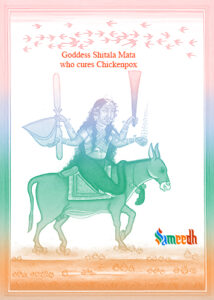In Hinduism, Chickenpox refers to “worship of Mata” a specific tradition or practice associated with certain goddesses, especially Goddess Shitala. This tradition is more commonly followed in North India.

Here’s why chickenpox is sometimes associated with the worship of Mata:
- Goddess Shitala: In North India, during the time of a chickenpox outbreak, people often worship Goddess Shitala, who is believed to be the goddess of coolness and healing. It is believed that by appeasing Goddess Shitala, she will protect individuals, especially children, from the severe symptoms and complications of chickenpox and other infectious diseases. Worshiping her is a way to seek her blessings and ask for relief from the discomfort caused by the illness.
- Protective Deity: In Hinduism, various deities are associated with specific attributes and qualities. Goddess Shitala is considered a protective deity who can shield individuals from diseases and discomfort. Worshiping her is a way of invoking her protection and healing.
- Cultural and Traditional Practice: The association of Mata (the divine mother or goddess) with chickenpox is a cultural and traditional practice that has been passed down through generations. It is a way to connect with the cultural and religious heritage and seek solace and protection during times of illness.
It’s important to note that this practice is not universal across all of Hinduism, and it is more prevalent in certain regions and communities. Not all Hindus observe this tradition, and practices can vary widely within the religion. The association between chickenpox and the worship of Mata is specific to certain cultural beliefs and customs within Hinduism and is not a universal practice throughout the religion.